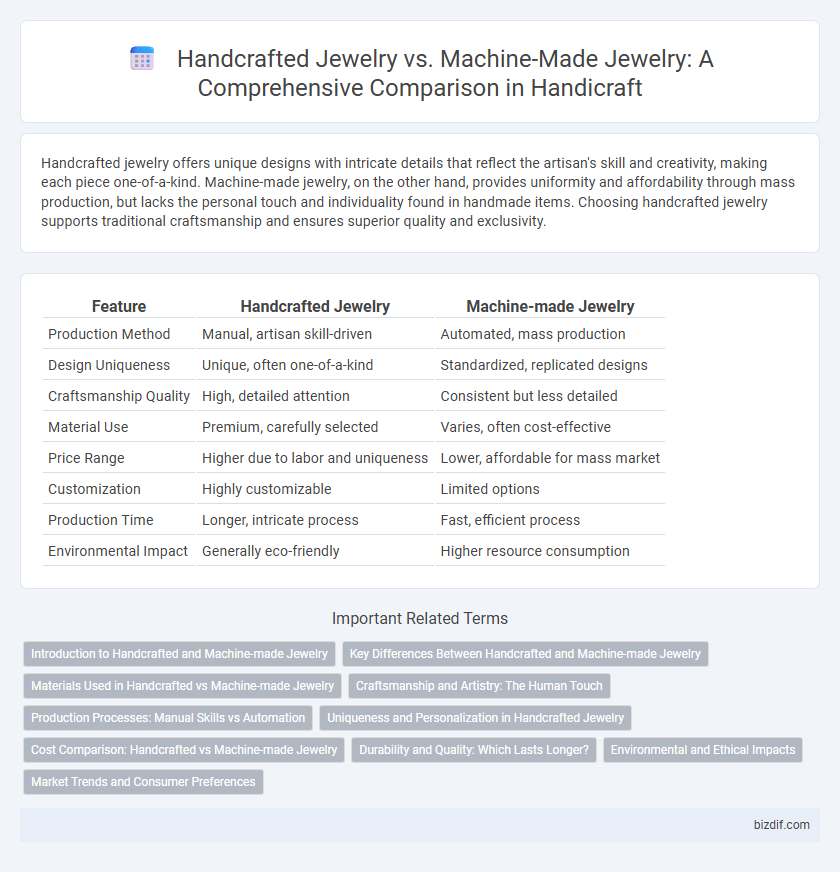Handcrafted jewelry offers unique designs with intricate details that reflect the artisan's skill and creativity, making each piece one-of-a-kind. Machine-made jewelry, on the other hand, provides uniformity and affordability through mass production, but lacks the personal touch and individuality found in handmade items. Choosing handcrafted jewelry supports traditional craftsmanship and ensures superior quality and exclusivity.
Table of Comparison
| Feature | Handcrafted Jewelry | Machine-made Jewelry |
|---|---|---|
| Production Method | Manual, artisan skill-driven | Automated, mass production |
| Design Uniqueness | Unique, often one-of-a-kind | Standardized, replicated designs |
| Craftsmanship Quality | High, detailed attention | Consistent but less detailed |
| Material Use | Premium, carefully selected | Varies, often cost-effective |
| Price Range | Higher due to labor and uniqueness | Lower, affordable for mass market |
| Customization | Highly customizable | Limited options |
| Production Time | Longer, intricate process | Fast, efficient process |
| Environmental Impact | Generally eco-friendly | Higher resource consumption |
Introduction to Handcrafted and Machine-made Jewelry
Handcrafted jewelry is meticulously created by skilled artisans, emphasizing unique designs, intricate detailing, and the use of traditional techniques that result in one-of-a-kind pieces. Machine-made jewelry relies on automated processes and mass production technology, enabling high-volume output with consistent shapes and finishes but often lacking personal touch. The contrast highlights the artisanal value and customization of handcrafted pieces against the efficiency and uniformity of machine-made jewelry.
Key Differences Between Handcrafted and Machine-made Jewelry
Handcrafted jewelry features unique designs created by skilled artisans, emphasizing intricate details and personalized touches that make each piece one-of-a-kind. Machine-made jewelry is mass-produced using automated processes, ensuring uniformity, faster production, and lower costs but often lacks the distinct character and craftsmanship of handmade items. The key differences lie in production techniques, customization levels, material quality, and the overall value perceived by buyers who seek originality versus affordability.
Materials Used in Handcrafted vs Machine-made Jewelry
Handcrafted jewelry often features high-quality, natural materials such as ethically sourced gemstones, sterling silver, and 24k gold, emphasizing uniqueness and artisanal value. Machine-made jewelry commonly utilizes mass-produced components, including plated metals and synthetic stones, prioritizing cost efficiency and uniformity. The material selection in handcrafted pieces results in durable, personalized items with distinct textures, whereas machine-made jewelry focuses on replicability and affordability.
Craftsmanship and Artistry: The Human Touch
Handcrafted jewelry showcases unparalleled craftsmanship and artistry, reflecting the artisan's skill, creativity, and attention to detail in every piece. Each item embodies a unique human touch that machine-made jewelry often lacks, resulting in limited-edition designs with personalized elements. This human involvement ensures that handcrafted jewelry carries a distinct character and emotional value, making it more meaningful and exclusive.
Production Processes: Manual Skills vs Automation
Handcrafted jewelry relies on skilled artisans who meticulously shape, cut, and assemble each piece using traditional tools, ensuring unique details and personalized designs. In contrast, machine-made jewelry employs automated technologies like computer-aided design (CAD) and precision casting to produce high volumes with consistent quality and faster turnaround times. The manual skill involved in handcrafted jewelry results in distinctive artistry, while automation emphasizes efficiency and uniformity in production.
Uniqueness and Personalization in Handcrafted Jewelry
Handcrafted jewelry offers unparalleled uniqueness due to the artisan's meticulous attention to detail and creative expression, making each piece a one-of-a-kind work of art. Personalization in handcrafted jewelry allows customers to collaborate directly with artisans, ensuring custom designs that reflect individual style and meaningful symbolism. Machine-made jewelry, while consistent and mass-produced, lacks the distinct character and bespoke quality inherent in handcrafted creations.
Cost Comparison: Handcrafted vs Machine-made Jewelry
Handcrafted jewelry typically costs more than machine-made jewelry due to the labor-intensive process and unique craftsmanship involved. Machine-made jewelry benefits from mass production techniques, significantly reducing manufacturing costs and allowing for lower prices. The personalized detail and higher quality materials used in handcrafted pieces often justify the premium price compared to the standardized, less costly machine-made alternatives.
Durability and Quality: Which Lasts Longer?
Handcrafted jewelry typically exhibits superior durability and quality due to meticulous attention to detail and the use of high-quality materials, often resulting in pieces that withstand wear and tear longer than machine-made counterparts. Machine-made jewelry, while produced with precision, may rely on standardized processes and lower-cost materials that can compromise longevity. Investing in handcrafted pieces ensures unique craftsmanship and robust construction that often outperforms mass-produced jewelry in lasting value.
Environmental and Ethical Impacts
Handcrafted jewelry often has a lower environmental impact due to the reduced energy consumption and minimal waste generated during the creation process compared to machine-made jewelry. Ethical considerations favor handcrafted pieces as they typically involve fair labor practices and support artisan communities, unlike mass-produced jewelry which may be linked to exploitative labor conditions. Sustainable sourcing of materials is more prevalent in handcrafted jewelry, further enhancing its eco-friendly and ethical benefits.
Market Trends and Consumer Preferences
Handcrafted jewelry commands a growing market share due to increasing consumer demand for unique, artisanal pieces that emphasize craftsmanship and ethical sourcing. Machine-made jewelry remains popular for its affordability, uniformity, and mass production capabilities, appealing to budget-conscious buyers and fast fashion markets. Industry reports indicate a shift towards handcrafted designs in luxury segments, driven by millennial and Gen Z consumers prioritizing sustainability and personalized style.
Handcrafted Jewelry vs Machine-made Jewelry Infographic

 bizdif.com
bizdif.com